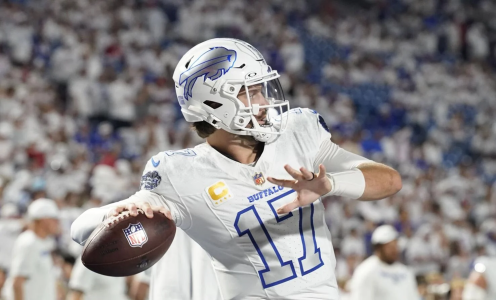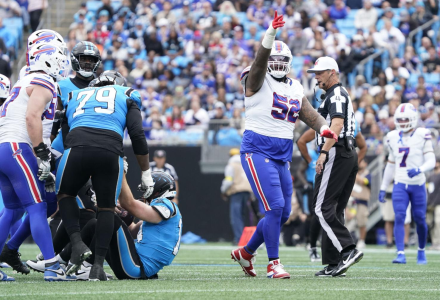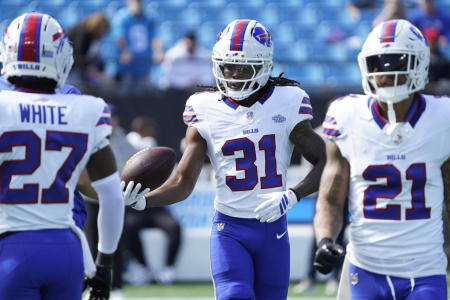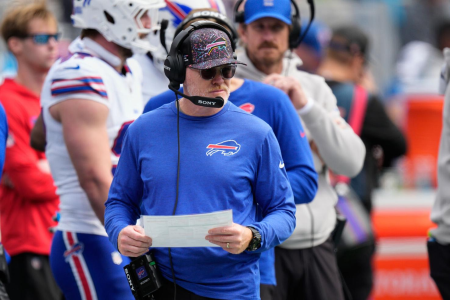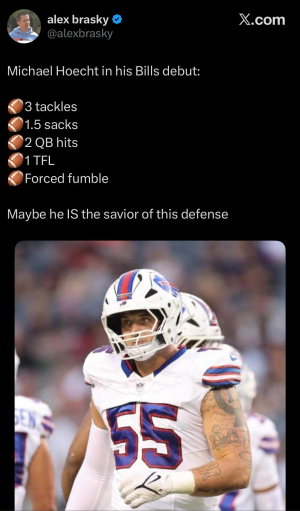Some of the wide receiver numbers out of the blowout win are shocking.

www.nytimes.com
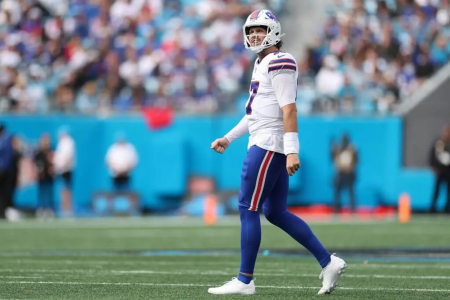 Josh Allen of the Buffalo Bills looks on in the second quarter of the game against the Carolina Panthers. Grant Halverson / Getty Images
Josh Allen of the Buffalo Bills looks on in the second quarter of the game against the Carolina Panthers. Grant Halverson / Getty Images
After two weeks to stew on their first two-game losing streak heading into a bye under head coach Sean McDermott, the Buffalo Bills answered back in a big way.
Their Week 6 loss “lingered” with them, according to Bills quarterback Josh Allen, and their response against the Carolina Panthers was close to immediate on Sunday. With one defensive stop and turnover after the next, along with some converted drives, the Bills blew out the Panthers 40-9 and improved their record to 5-2. The Bills are now 9-0 in the game after the bye under McDermott.
But even in such an impressive showing, there is a lot to take away from the Bills’ victory — and not all of it is positive.
Let’s dive in:
Defense teases some end-of-season potential
For the first time in 2025, the Bills’ defense put together a complete game. Throughout their first six games, the Bills showed flashes — whether it was a half, a few quarters, or even on early downs, it really depended on the outing. Even with those moments of brilliance throughout those six weeks, there were routine in-game breakdowns when the defense was gashed for yards and points. It was mostly unpredictable as to when during a game those lulls would hit, and it would force the offense to try and bail them out.
Against the Panthers, the offense never had to bail the defense out. Right from the start, the Bills employed different strategies and personnel that led to excellent results. Although they had some lapses as a run defending unit, particularly against Rico Dowdle, they held the Panthers’ top rushing duo to just 88 yards during the game. Most importantly, they did a much better job forcing longer distances on third down to increase their chances of making game-changing plays. On average, before the game entered garbage time, the Panthers’ average to-go distance on third downs was 8.6 yards.
On top of that, the turnovers returned in a big way. They harassed Panthers quarterback Andy Dalton all game. Ahead of garbage time, the Bills totaled six sacks, they forced two fumbles, recovered both of them, and, of course, had the game-defining A.J. Epenesa interception that put the Bills on the doorstep of another touchdown — and total control of the game. The Panthers managed only 4.1 yards per play before the Bills’ starters came out.
The Bills mixed in some intriguing youth, like rookie cornerback Maxwell Hairston, who played every other defensive series in his NFL debut. They also worked in impressive rookie safety Jordan Hancock on obvious passing situations, the first defensive role of consequence in his NFL career. Defensive end Michael Hoecht, who had been suspended for the first six games, played a massive role right away. Not only was he a heavily used rotational defensive end, but on most of the obvious passing situations on third down, Hoecht would sub in at defensive tackle to give them a leveled-up rusher. The defense felt fresh, and it set the tone for the entire game.
While being completely complimentary of its day, we can also call this game what it is for the defense. The Bills faced a backup quarterback whose best days are behind him and who no longer has any mobility. The Bills had every opportunity to dominate this matchup, and, to their credit, they did. Their next challenge is to have a complete game against a better offensive opponent and to see if these young defensive players can take that step forward, too. But the fact that they made it easier on the offense, and the underlying metrics behind the offense’s showing, leads us to a more significant point.
The passing game is still missing in action — and some WR stats are damning
Before we get to the very, very large elephant in the room, and part of what I’m sure are the discussions happening with the Bills’ brain trust at the moment, you have to give credit where it’s due. Running back James Cook and the offensive line, the overwhelming strength of the Bills’ offense, dominated the Panthers.
It really seemed like the offensive line had a point to prove after what had happened during the Week 6 loss to the Atlanta Falcons. In that game, the Falcons helped contain a Bills’ rushing attack that had been so dynamic earlier in the season, and there were free defenders uncharacteristically finding their way to contact with Cook at or near the line of scrimmage. Even though the Bills employed similar running concepts all game, the offensive line forced the issue, dominated at the point of attack and gave Cook an incredible cushion to get through the lane. Combine that with Cook’s patience, vision and explosiveness, and that duo made it easy on quarterback Josh Allen and offensive coordinator Joe Brady.
However, just because the Bills put up 40 points and 245 yards on the ground does not erase the overarching theme about the Bills’ passing offense. Somehow, despite having one of the best quarterbacks in the world, every time he drops back to pass, it’s a stressful situation for the Bills.
At one point in the press conference, McDermott was asked about the rushing performance because, as the asking reporter put it, he “loves the run.” McDermott, who said he never said that, defended his outlook perhaps a bit ironically.
“I know the value of being a two-dimensional offense,” McDermott said.
And now, the pendulum has swung so far to the rushing side that the Bills, who once had among the most dynamic passing attacks in the NFL, have become a one-dimensional rushing team with personnel issues. The formula? Run the ball, quick passes and rely on blocking to manufacture yards after the catch. That notion of being two-dimensional isn’t likely to leave McDermott’s mind anytime soon, and nor should it.
If you want a microcosm of the Bills’ passing experience enveloped in one play, look no further than their third-and-6 play at the beginning of the third quarter in Panthers territory. Allen, with Keon Coleman, Khalil Shakir, Elijah Moore, Dalton Kincaid and Ty Johnson on the field, took the shotgun snap and hung in the pocket, going through his progressions for 4.35 seconds — well past how long an offensive line generally gives its quarterback to throw. No one was open. Then, wanting to give his receivers another chance to get open, Allen spun out of the pocket and rolled to his left, holding the ball for an additional 6.51 seconds — at one point running through someone grabbing and ripping part of his uniform — before ultimately taking a 16-yard sack. That’s right, almost 11 seconds, and absolutely no one was open down the field, even in a scramble drill scenario.
Allen always takes the blame head-on, saying he didn’t trust his feet and that he needs to be better at going through his progressions. He brought up one throw he missed to Moore, which, to be fair, he did, but the reason he’s probably beating himself up over it is because it was the only time all game a wide receiver was uncovered enough more than 15 yards from the line of scrimmage to warrant a target. You read that correctly. That target was the only time, all game, that Allen attempted a pass to a wide receiver that went further than 15 yards.
Halloween is around the corner, and spooky season is here, but the passing stats are downright ghoulish. Buckle up. On all 19 of Allen’s passing attempts, his receiver’s average depth of target was 6.11 yards down the field. On his 12 completions, the average depth of the target shrinks to 3.92 yards per completion. That means 71.2 percent of Allen’s passing yards were after the catch.
If you think that’s worrisome, let’s isolate the wide receivers. Of Allen’s 12 attempts to the wide receiver group on Sunday, his average depth of target decreased to 4.75 yards. He completed eight of those passes, with an average depth of target of 0.75 yards. In total, Allen gained only six yards with his arm to receivers through the air. The other 104 yards came after the catch. Allen did not complete a single pass to a wide receiver over 8 yards. He only completed a pass of over four air yards one time the entire game.
Now to the anti-magnum opus — let’s remove Shakir from the equation and focus solely on the boundary receivers. Allen completed only two passes for 22 yards to those receivers, all game, with a 40 percent completion rate. Coleman had both receptions.
So what’s the point? The Bills aren’t always going to be facing teams with a backup quarterback surrendering the ball all game long. They can’t depend solely on the running game every week. They are going to be down in some games and need to rely on their passing attack to get them out of trouble. There will be teams that, like the Bills saw in Weeks 5 and 6, will dare them to throw by bottling up their ground game. If the Bills don’t have an answer early in games, there really isn’t much confidence they’ll be able to do it late. There have been no signs since the first week of the season that the Bills can be a consistent enough team, outside the numbers, to win through the air. As good as the Panthers game was, the Bills do not have the two-dimensional offense they want — and the one they’ll need to have to win a Super Bowl.
With the Nov. 4 trade deadline closing in, and the more the evidence mounts, the more it becomes crystal clear. The Bills desperately need another boundary receiver. They need to be able to challenge defenses past 20 yards through the air. Heck, they need to challenge defenses past 10 yards. If they want to unlock their MVP quarterback and reinstall some of the magic the offense has lost, they must go out and strike for a receiver who can instantly become a starter, and potentially Allen’s top target outside the numbers. And in doing so, it might make their running game
even better. It will be costly, and the Bills will want to find the right situation, but the need is as clear as day. It all depends on how much the Bills are willing to spend to get the right receiver.
Ed Oliver is one of many Bills defensive tackles to have sustained injuries this season.Bob Donnan / Imagn Images
Ed Oliver’s injury puts even more focus on the multi-pronged trade deadline
With his immediate rule out after sustaining a biceps injury, things certainly do not sound promising for starting three-technique defensive tackle Ed Oliver. It’s gone from bad to worse for the Bills at defensive tackle. T.J. Sanders, who began the year as Oliver’s primary backup, is on Injured Reserve for at least two more games with a knee injury. DaQuan Jones, a one-technique who filled in for Oliver at three-technique during Oliver’s prior four-game absence, popped his calf ahead of the Falcons game and hasn’t been visible to the media at team facilities since. The Bills also lost DeWayne Carter for the year due to a torn Achilles tendon.
If there’s one encouraging thing, it’s that the Bills felt good enough about the Jones calf injury that they didn’t put him on IR. But in the interim, without Jones on the practice field in any capacity last week, thinking he’ll be able to return for the Chiefs game in Week 9 seems far-fetched. That means the Bills will head into this week with two healthy defensive tackles on their 53-man roster — rookie one-technique Deone Walker, and versatile veteran reserve Larry Ogunjobi. Even if they signed practice squad defensive tackle Jordan Phillips to the 53-man roster, they still only have three. Of all the potential options, striking a deal for someone like the New York Jets’ Harrison Phillips, who spent four years in Buffalo before leaving in free agency, would make sense given his familiarity with the scheme. Trading for a defensive tackle, regardless of his position, might be necessary — as early as this week. That, along with trading for some safety depth and a receiver, could be high on the priority list.

